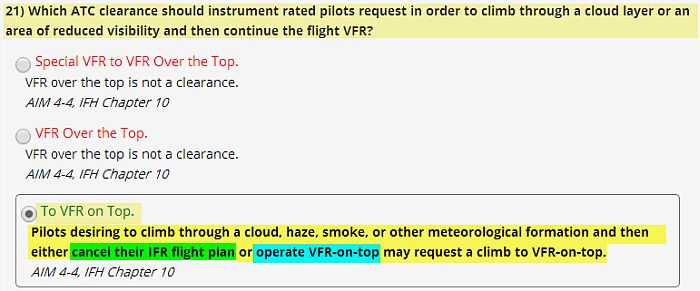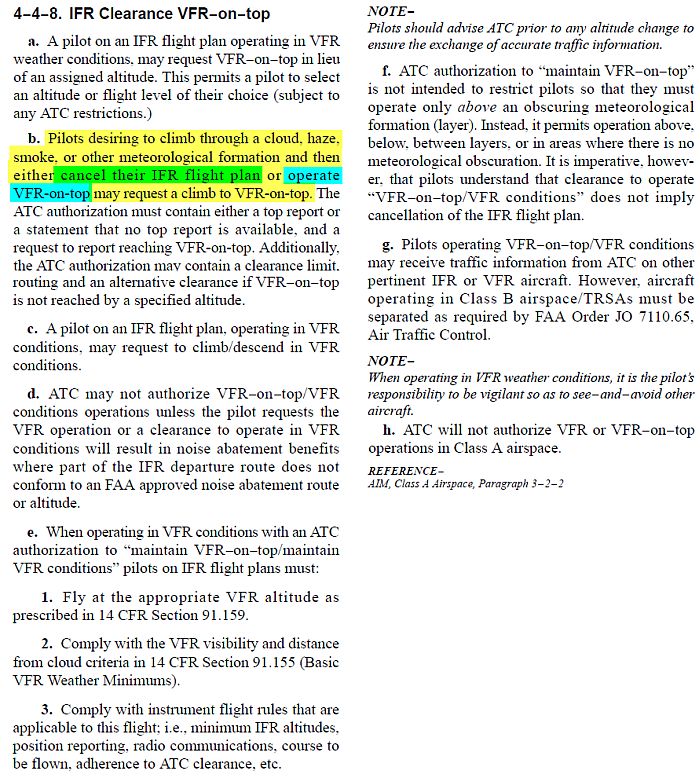No, you didn't say it, you implied it.
If you would read the article, the example is nothing more than a short range clearance but with OTP for the requested altitude. Now, I suppose they could just file IFR with a hard IFR altutude and hope to get on top but it seems to me more logical just to request OTP. You don't need to worry about an altitude assignment, just climb til you're 1,000 ft above the obscuration, cancel, then do whatever VFR manuvers that need to be done.
Requesting VFR-on-Top provides no advantage over filing IFR with a hard altitude
when the pilot intends to cancel IFR upon reaching VFR conditions. Let's look at some examples.
Pilot requests VFR-on-Top to climb above a layer, ATC has IFR traffic at 5000:
The clearance; "...cleared to PHYXE via radar vectors, climb to and report reaching VFR-on-Top, tops reported 2800, if not on top by 4000 maintain 4000 and advise..." The pilot climbs through 3800 and cancels IFR.
Pilot requests an IFR clearance with a hard IFR altitude to climb above a layer, ATC has IFR traffic at 5000:
The clearance; "...cleared to PHYXE via radar vectors, climb and maintain 4000..." The pilot climbs through 3800 and cancels IFR.
Pilot requests VFR-on-Top to climb above a layer, ATC has no other traffic, the controller's airspace extends from the surface to 10,000 MSL:
The clearance; "...cleared to PHYXE via radar vectors, climb to and report reaching VFR-on-Top, tops reported 2800, if not on top by 10,000 maintain 10,000 and advise..." The pilot climbs through 3800 and cancels IFR.
Pilot requests an IFR clearance with a hard IFR altitude to climb above a layer, ATC has no other traffic, the controller's airspace extends from the surface to 10,000 MSL:
The clearance; "...cleared to PHYXE via radar vectors, climb and maintain 10,000..." The pilot climbs through 3800 and cancels IFR.
The only difference,
given that the pilot will cancel upon reaching VFR conditions and thus will not actually operate VFR-on-Top at any time, is requests for VFR-on-Top elicit lengthier clearances.
I probably gave a hundred OTP clearances to helos flying from NKX to NFG. You have an H-53 socked in at NKX with a marine layer but needs to get on R2503. The purpose isn't to retain their IFR all the way to NFG but to cancel at some point and go to the range. With no tops report and no reason to maintain an IFR altitude all the way to NFG, an OTP clearance is the way to go.
So you believe, yet you cannot explain why you believe that is so when the pilot will cancel upon reaching VFR conditions and not actually operate VFR-on-Top at any time.
Not sure why those types of OTP clearances are so confusing to you. Just because it's not common in GRB doesn't mean they don't do it elsewhere.
There is nothing about this subject that is confusing to me. Perhaps it's not common in GRB because pilots in this area have a better understanding of VFR-on-Top than do pilots in California.





